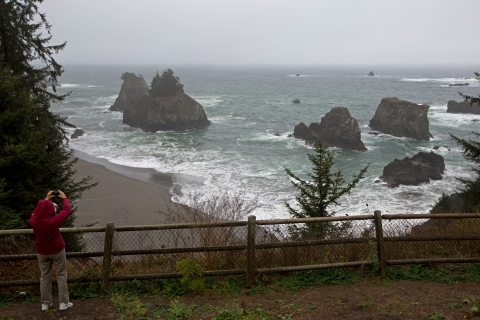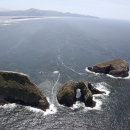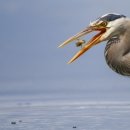About Us
From nearly every viewpoint on the Oregon coast, colossal rocks can be seen jutting out of the Pacific Ocean, stark monoliths amidst a pounding surf. Established on May 6, 1935, as a sanctuary and breeding ground for seabirds and marine mammals, the scenic and rugged Oregon Islands NWR includes 1,853 rocks, reefs, and islands and stretches from Tillamook Head near Seaside south to the California border. All of the rocks and islands of the Refuge are designated National Wilderness Areas, with the exception of 1-acre Tillamook Rock. Most of Oregon’s estimated 1.2 million nesting seabirds use Oregon Islands Refuge as a place to raise their young, and Oregon’s seals and sea lions use the islands as a place to haul out and rest or to give birth to their pups.
Wilderness Area
Oregon Islands Wilderness area was designated by congress by Public Law 91-504 on October 23, 1970. Additional lands were added to the Oregon Islands Wilderness in 1978 and 1996. All of the off shore portions of the Oregon Islands NWR are designated as wilderness, comprising a total of 593.1 acres. The Wilderness Act of 1964 created the National Wilderness Preservation System "in order to assure that an increasing population, accompanied by expanding settlement and growing mechanization, does not occupy and modify all areas in the United States, and its possession, leaving no lands designated for preservation and protection in their natural condition..." The Oregon Islands Wilderness protects millions of seabirds from human disturbance and development that could harm this crucial nesting habitat.
For more information about Oregon Islands Wilderness, visit Wilderness.net.
Our Mission
The 1,854 wave-washed rocks and islands spanning the Oregon coast from Tillamook Head to the California border are protected as Oregon Islands National Wildlife Refuge. These isolated landforms lie above the line of mean high water and provide nesting habitat for an estimated 1.2 million seabirds, more than the habitat along the coastlines of California and Washington combined. These rocky islands and reefs also serve as haul-outs for pinnipeds including Harbor Seals, Northern Elephant Seals, California Sea Lions, and the Steller Sea Lion, which haul themselves up on to rocks to give birth, to rest, and to molt.
Our History
From nearly every viewpoint on the Oregon coast, colossal rocks can be seen jutting out of the Pacific Ocean, stark monoliths amidst a pounding surf. Established on May 6, 1935, as a refuge and breeding ground for seabirds and marine mammals, the scenic and rugged Oregon Islands Refuge includes 1,853 rocks, reefs, and islands and stretches from Tillamook Head near Seaside south to the California border. All of the rocks and islands of the refuge are designated Wilderness Areas, with the exception of 1-acre Tillamook Rock. Most of Oregon’s estimated 1.2 million nesting seabirds use Oregon Islands Refuge as a place to raise their young, and Oregon’s seals and sea lions use the islands as a place to haul out and rest or to give birth to their pups.
The refuge also protects two headlands: Coquille Point and Crook Point. The 19-acre Coquille Point, acquired in 1991, is located on the western edge of the city of Bandon. The headland provides a buffer zone between mainland development and the islands. It is a spectacular place to watch seabirds and harbor seals and serves as a gateway to Bandon's beach. A paved trail winds over the headland and features interpretive panels that share stories about the area's wildlife.
The 134-acre Crook Point Unit was acquired in 2000 and is located along the southern Oregon coast just south of Gold Beach. It contains rare plants, unique geological formations, and one mile of pristine beach with interspersed rocky intertidal areas. It's also a buffer, protecting seabird colonies from encroaching development. It is next to the Mack Reef archipelago home to the second-largest concentration of nesting seabirds in Oregon. This headland is closed to public use.
The 14-acre Whale Cove Unit on the central Oregon Coast is the most recent addition to Oregon Islands National Wildlife Refuge. Acquired in December 2014, the property is two miles south of Depoe Bay in Lincoln County. It surrounds the oldest marine reserve in Oregon, where all marine life is protected. The site will be managed for its natural resource values and to protect Whale Cove’s ecology. The cove provides scenic views from nearby Rocky Creek State Park and US Highway 101. Learn more about Whale Cove HHH.
Origin of the Rocky Shoreline
Did you ever wonder how Oregon got its magnificent shoreline? The west coast—including Washington, Oregon and Northern California—was formed as a portion of the Pacific sea floor continental plate slides slowly eastward underneath the plate that composes the Americas.
Over millions of years, rivers such as the Columbia and Fraser dumped a layer of sediment almost two miles in depth onto the sea floor—the plate of Juan de Fuca. As the Juan de Fuca plate crawls slowly beneath the coast, that sediment thickens beneath the edge of the continent, which is forced upward and forms the coastal mountain ranges: the Olympics, Willapa Hills, Klamath Mountains, and Oregon Coast Range. This unique coastline, weathered by eons of wind and waves, features rocky intertidal zones festooned with invertebrates, sea stacks teeming with shorebirds, and ideal haul-outs for marine mammals.
Other Facilities in this Complex
Oregon Islands National Wildlife Refuge is managed as one of six Refuges in the Oregon Coast National Wildlife Refuge Complex. See below for the other five Refuges and experience them all.
Refuge Headquarters:
Oregon Coast National Wildlife Refuge Complex
2127 SE Marine Science Drive
Newport, OR 97365
541-867-4550
oregoncoast@fws.gov
What is a Refuge Complex?
A National Wildlife Refuge Complex is a group of two or more refuges, wildlife management areas or other refuge conservation areas that are managed from one central office. Refuges are grouped into a complex because they occur in a similar ecological region, such as a watershed or specific habitat type, and have a related purpose and management needs.
The Oregon Coast National Wildlife Refuge Complex is managed from our headquarters in Newport, Oregon. The office located at Bandon Marsh NWR serves as a south-coast field office.





